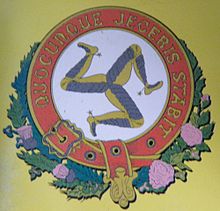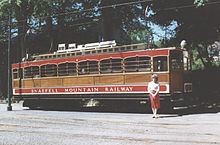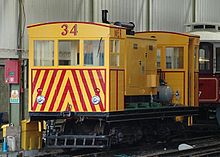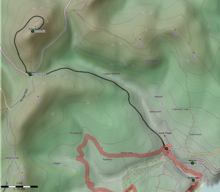
Snaefell Mountain Railway
About this schools Wikipedia selection
SOS Children volunteers helped choose articles and made other curriculum material Child sponsorship helps children one by one http://www.sponsor-a-child.org.uk/.
The Snaefell Mountain Railway is an electric mountain railway on the Isle of Man in Europe. It joins the town of Laxey with the summit of Snaefell, at 620 metres (2,034 ft) above sea level the highest point on the island. It connects with the Manx Electric Railway (MER) in Laxey. The line is 5 miles (8.0 km) long, built to 3 ft 6 in (1,067 mm) gauge and uses a Fell Incline Railway System centre rail for braking on the steep gradients. It is electrified using overhead wires at 550 volts direct current, with bow collectors.
Operation
Services operate at regular intervals between April and September, taking 30 minutes for a one-way journey. There is no winter service: the overhead wires on the exposed upper part of the route are dismantled to avoid damage from icing. All passenger traffic is carried in six wooden-bodied electric railcars, built in 1895 and numbered 1 to 6. Car 5 was burned out in an accident in 1970 and its body is a replacement built in 1971 to a similar design. The cars were re-equipped in the late 1970s with new bogies to a design based on the original, using motors and traction equipment from withdrawn Aachen trams. Because of the different gauge and the centre rail, vehicles cannot inter-run between the railway and the 3 ft gauge MER. Railway vehicles are occasionally worked to the MER workshops at Douglas by swapping their bogies, and to aid this there is a dual gauge siding in Laxey. The railway is owned and operated by Isle of Man Heritage Railways, a department of the Isle of Man Government.
History
The line was originally surveyed by George Nobel Fell, the son of John Barraclough Fell who invented the Fell system. This survey was for a steam-operated railway using the Fell centre rail for both propulsion and braking, and the scheme was approved by Tynwald in 1888 but not built. In 1895 the Snaefell Mountain Railway Association (SMRA) revived the plans, and adopted the route of the earlier survey. As the line was built entirely on land leased by the association there was no need for statutory powers, and the line was constructed very quickly and opened on 20 August 1895. The line was built from scratch as an electric railway without Fell traction equipment, relying on normal rail adhesion for propulsion up the steep gradients. However they are fitted with Fell braking equipment for use when descending. In December 1895 the SMRA sold the line to the Isle of Man Tramways & Electric Power Co. Ltd (I.o.M.T.&.E.P.), which owned the M.E.R. Doubt was thrown on this transaction in aftermath after the later collapse of the I.o.M.T.&.E.P., when it was revealed that the SMRA was unregistered, and that most of the board of the IoMT&EP were also members of the SMRA and had voted on the acquisition in contravention of that company's articles of association. The IoMT&EP went into liquidation in 1900 as a consequence of a banking collapse. The railway and the MER were sold by the liquidator to the newly-formed Manx Electric Railway Co. Ltd, which took over in 1902. By the late 1950s the company was itself in financial difficulties, and it was acquired by the Isle of Man Government in 1957.
Stations
| Snaefell Mountain Railway | |||||||||||||||||||||||||||||||||||||
|---|---|---|---|---|---|---|---|---|---|---|---|---|---|---|---|---|---|---|---|---|---|---|---|---|---|---|---|---|---|---|---|---|---|---|---|---|---|
|
Legend
|
|||||||||||||||||||||||||||||||||||||
The main station on the line is the interchange with the coastal line at Laxey and this is where all departures and arrivals occur; the only intermediate stopping place on the line is at the mid-way position where the line intersects the Snaefell Mountain Course used by the world famous T.T. races and during race periods trams terminate either side of the road and passengers connect by means of a footbridge.
- Laxey Station
- Bungalow Station
- Snaefell Summit Station
There is a spur off the main line above the lower station which leads to the depôt where all the rolling stock is housed and maintained; this complex was completely rebuilt in the winter of 1994/1995 and officially opened it readiness for the railway's centenary. Also in the depôt is a smaller shed which houses the Air Ministry railcars used to access masts at the summit during the winter months when the overhead lines are removed from the top section of the line to prevent frost damage.
In November 2010 works commenced on a project to renew several sections of track on the Snaefell Mountain Railway. Works are scheduled for completion prior to the line reopening for the 2011 season.
Rolling stock
Passenger
The railway operates with six identical tramcars, all of which were built 1895 by George F. Milnes & Co., and delivered in time for the line's opening that year. Of note is Car No. 5 which was severely damaged by a fire on 16 August 1970 and subsequently re-built locally, re-entering service in 1971. It was distinguished by having modern aluminium framed "bus" type windows but these were removed and wooden sliding ones re-fitted during a subsequent re-build in 2003, at which time the tram became the first to carry the railway's name in Manx along its side. The current livery has been standard for over a century, save for a period upon nationalisation in 1957 when certain cars carried an unpopular green and white scheme. The original livery used until 1899 was a cream and Prussian Blue scheme featuring "tramway" wording (rather than "railway" which has since been favoured). With the extensive rebuild of Car No. 1 commecning in 2011, this car has been chosen to revert to the original colour scheme complete with original wording, the first time a markedly different livery has been carried by any of the cars since the abolition of the short-lived nationalisation (green and white) colour scheme in 1962. Until the addition of rheostatic braking equipment on car roofs in 1970 knifeboard adverts were carried on the roof tops.
Departmental
The seventh car was built by the railway was a non-passenger car supplied at opening in 1895. It was based largely upon the passenger cars but without any seated closed accommodation. Numbered 7 in sequence with the other stock and nicknamed "Maria" it was used to convey coal from Laxey to the power station near the Bungalow and traditionally borrowed traction bogies from other passenger vehicles as required. It latterly saw many years at the works depot mounted on barrels until it became completely rotten and beyond saving. A replica was built in 1994 to feature as part of the International Railway Festival celebrating the line's centenary, and this saw limited use on the line and later this was converted for use on the Manx Electric Railway and re-gauged to 3 ft (36 in) and this now re-numbered as Car No. 34 on the "low road", the colloquial name for the coastal section to differentiate it from the mountain line. It features a mounted diesel generator for self propulsion when the overhead wires are down. The railway also has a four wheeled wagon used to carry supplies to the summit station which has no road access, this is ordinarily propelled in front of the first morning car which delivers the staff to the station and remains at the summit during the operational day, returning behind the last tram; it is occasionally used on service cars as part of special events period, primarily for photographic purposes. It, and all other stock, has no couplings as the line is continually on a gradient and no runaways can occur.
National Air Traffic Services
There have been four different railcars on the line all of which are Wickham trolleys, starting with Air Ministry No. 1 (works number 5864) arriving in 1951, in Air Force Blue livery; it was repainted into yellow and black (Civil Aviation Authority colours) in the 1960s and sold to Manx Electric Railway in 1977. It has since been sold to private owner and shipped to the UK in June 2007 for restoration. The second car was CAA No. 2 (works number 7642) arriving in 1957 in Air Force Blue livery, again repainted into yellow and black in the 1960s. It was returned to Wickham Rail in 1991 as part exchange for No. 4 and possibly re-exported to Southern Africa. No. 3 (works number 10956) arrived in 1977 and is currently reserve vehicle for the final car, No. 4 (works number 11730) which arrived in 1991 and is currently in use by National Air Traffic Services (the successor of the Air Ministry and Civil Aviation Authority). The vehicles were used to maintain the aerial masts at the top of Snaefell mountain.
Route
| Preceding station | Snaefell Mountain Railway | Following station | ||
|---|---|---|---|---|
| Laxey | Laxey - Summit | Snaefell Summit |
Incidents
On Monday, 27 July 2009, a vehicle carrying a mechanical excavator came into contact with wires supplying traction power to the Snaefell Mountain Railway and the Manx Electric Railway at a crossing in Laxey, according to portal site Manx.net. There were no injuries. Police and MER electrical engineering crews were at the scene of the incident, the report also said. It did not indicate what damage had occurred as a result of the incident. Service resumed the next day after temporary repairs to the overhead lines, which were permanently repaired over the next couple of weeks.








